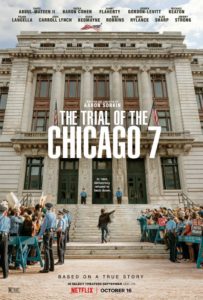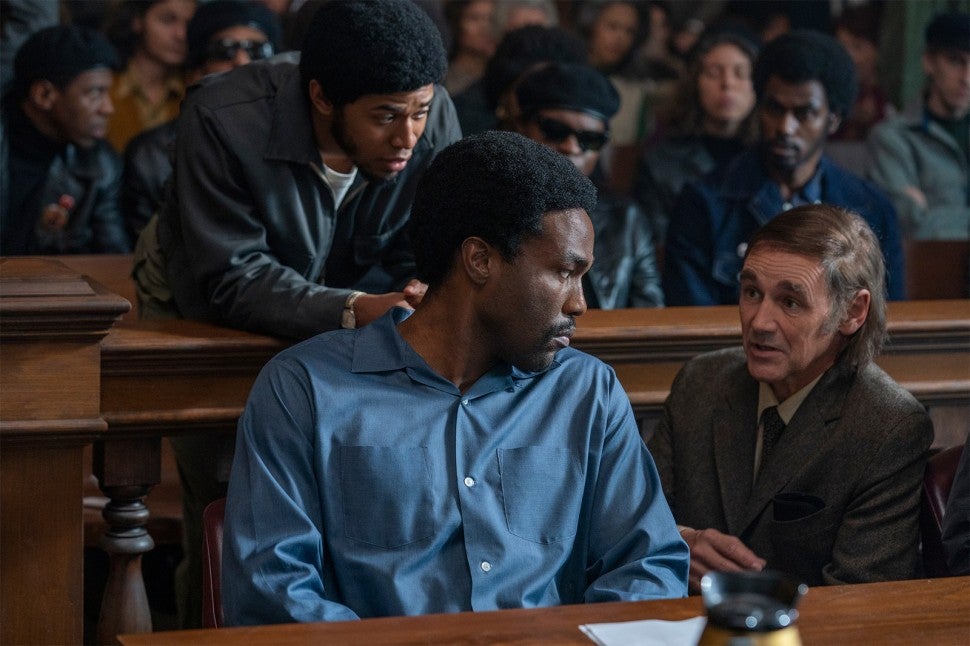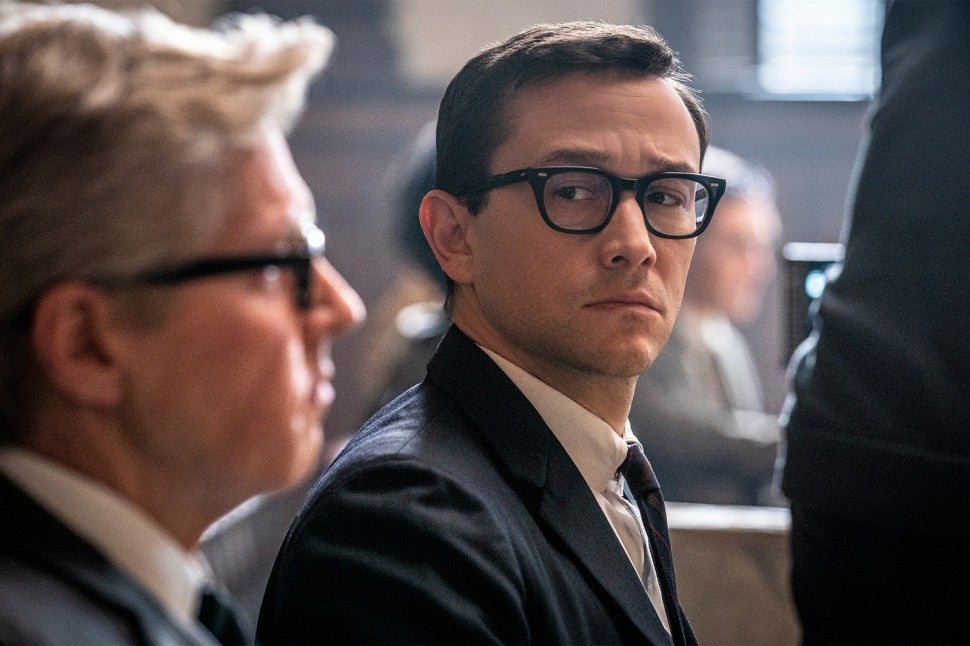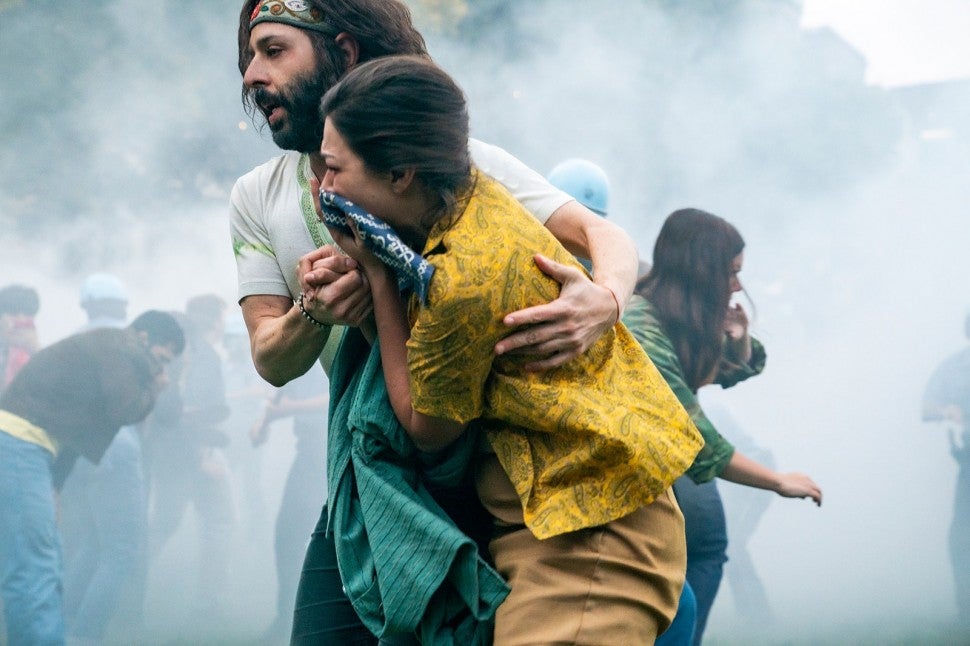History in the dock: Netflix movie re-examines trial against counterculture figures
DIRECTED BY AARON SORKIN/2020

Parallels have been drawn between the chaos that consumed the nation in 1968 and our society today.
News reports of civil unrest regularly make headlines now as they did 52 years ago. We are again in the midst of a highly contentious presidential election. Questions continue to linger over whether the government is using its substantial resources to quell dissent.
Aaron Sorkin raises these issues in his new film, The Trial of the Chicago 7. The movie was released in selected theaters in late September and has been streaming on Netflix since Oct. 16.
The film stars Sacha Baron Cohen, Eddie Redmayne, Yahya Abdul-Mateen II, Jeremy Strong, Mark Rylance, Joseph Gordon-Levitt and Frank Langella. Sorkin is known for screenwriting on movies such as A Few Good Men, Moneyball and The Social Network as well as the broadcast television/cable dramas “Sports Night,” “The West Wing” and “The Newsroom.” He first expressed an interest in what became The Trial of the Chicago 7 more than a decade ago, initially with Steven Spielberg as director.
The movie chronicles the federal trial that began in September 1969 against anti-war leaders who participated in protests during the previous year’s Democratic National Convention in Chicago. Numerous antics by the defendants and notably unfair rulings by Julius Hoffman (Langella), the presiding judge, marked the court proceedings.
The trial initially oversaw criminal counts against eight individuals: Rennie Davis (Alex Sharp), David Dellinger (John Carroll Lynch), John Froines (Daniel Flaherty), Tom Hayden (Redmayne), Abbie Hoffman (Cohen), Jerry Rubin (Strong), Bobby Seale (Abdul-Mateen) and Lee Weiner (Noah Robbins). They were each charged with various federal crimes including conspiring to cross state lines to engage in violence and incite a riot, crossing state lines to engage in violence and incite a riot, and instructing others on how to make and use incendiary devices and impeding public safety authorities from carrying out their duties. All the defendants and their attorneys, including William Kunstler (Rylance), also were cited multiple times for contempt of court.

The movie shows the horrendous treatment that Seale sustained. His attorney was recovering from surgery, and he repeatedly demanded that he be allowed to represent himself. Judge Hoffman eventually had Seale gagged and chained to his chair.
At some point, Seale was severed from the trial. Prosecutors never refiled charges against him.
In February 1970, jurors acquitted Froines and Weiner of all charges. The other five were acquitted of the conspiracy charges but convicted of crossing state lines to engage in violence and incite a riot.
In November 1972, the U.S. Court of Appeals for the Seventh Circuit reversed all of these convictions. It cited examples of bias on the part of Judge Hoffman and the FBI’s bugging the offices of the defense attorneys. The U.S. Department of Justice declined to retry the case.
The movie is well cast and engaging. It highlights major concerns about the government’s attempts to silence critics. And seeing how the U.S. Department of Justice pushed its dubious charges against these defendants, the questions raised are legitimate.
The actors portraying the defendants do an excellent job. These men came from various backgrounds and approached their opposition to the Vietnam War in different ways. The film showcases how their contrasting styles merged in the long run as they defended their beliefs.
Langella is superb as Judge Hoffman. He is one of the finest character actors around, and it’s interesting to see what new roles he’ll take on.

One big question mark is how Rylance came to be cast as Kunstler, the primary defense lawyer. Kunstler was a huge man physically and had a bulldog personality. Rylance is average size and often seems withdrawn and cautious in his role.
Now, he did a fine acting job. If this were a generic courtroom drama, he would have fit in nicely.
But Kunstler was a larger-than-life individual. It was difficult watching Rylance trying to play someone so obviously different than himself.
Sorkin’s decision to move ahead with this project also is bewildering. Several other movies have been made about this trial, and they all focused on the same issue.
In 1987, HBO presented its own version with Conspiracy: The Trial of the Chicago 8. This interspersed courtroom dramatizations with videotaped interviews featuring key figures.
Released in 2007, Chicago 10: Speak Your Peace mixes animation with celebrity voiceovers and archival news footage of events of the time; the film based its script on transcripts of the legal proceedings and audio recordings of participants. The title refers to all eight original defendants as well as Kunstler and defense attorney Leonard Weinglass. After its limited theatrical release, the documentary was broadcast on the PBS program “Independence Lens” in 2008.
The Chicago 8 was a 2010 film. It also used transcripts from the trial.
So, the angle that Sorkin took on the federal prosecution of these defendants has been thoroughly explored. It’s uncertain what he hoped to glean out of this film that others hadn’t.
In addition, Sorkin took a fair number of liberties with the facts to lay out his narrative. This is concerning because it can mislead viewers about what really happened.
Sorkin said this movie isn’t a documentary, which is true. But history isn’t his script to rewrite.

History is an established series of events that previously occurred, and fudging the details plays fast and loose with reality. Writers and filmmakers may emphasize different aspects of a historical account to make different points. But they need to adhere as much as possible to the truth so as not to distort the events they’re highlighting.
Sorkin, for example, portrays federal prosecutor Richard Schultz (Gordon-Levitt) as far more sympathetic to the defendants and their cause then he actually was. Schultz said in a recent interview that the movie horribly twisted much of what he did during the trial.
If viewers don’t seek out these counter arguments, they won’t know this. While they may understand that the film deviates from the truth at some moments, they can’t comprehend to what extent this occurs unless they investigate the matter.
And frankly, far too many viewers wouldn’t think to undertake such an endeavor. This will leave them with the wrong impression of some parts of our nation’s past.
Sorkin wants to make points that may have nothing to do with the trial that took place. This is unfortunate because history has extraordinary narratives to relate. Storytellers need to trust these events to convey what’s true, not contort them while drafting their own versions for questionable purposes.


